
by Mary Caperton Morton Wednesday, December 23, 2015

Homo naledi's head as reconstructed by paleoartist John Gurche, who spent about 700 hours recreating it from bone scans. Credit: Mark Thiessen/National Geographic, for the October 2015 issue of National Geographic magazine.
The Rising Star Cave system, near Johannesburg, South Africa, has never been extensively explored because of its complexity and extremely narrow passages. But in 2013, when a team of intrepid cavers from the Speleological Exploration Club of South Africa pushed through a narrow 12-meter-long chute with an average width of only 20 centimeters, they discovered a chamber filled with what looked like human bones.
The cavers reported their find to Lee Berger, a paleoanthropologist at the University of the Witwatersrand who has studied the nearby Cradle of Humankind World Heritage Site. Berger organized an expedition including six female paleoanthropologists petite enough to pass through the chute to the room full of bones, dubbed the Dinaledi Chamber, or “the chamber of stars.” There, they recovered more than 1,500 bones belonging to at least 15 individuals — more fossils than have ever been recovered from any other single South African hominid site.
So far, the team has not been able to conclusively date the fossils, due to a lack of suitable material for dating in the cave, but the bones are thought to be evolutionarily similar to Australopithecus afarensis, which lived between 3.9 million and 2.9 million years ago. The physical features of the new fossils — including a slender, small braincase and very strong thumbs — are distinct enough from any known early hominid to earn them classification as a new species: Homo naledi.
The fossils and new species were described in a series of papers published in the journal eLife, one of which concludes that Homo naledi likely buried their dead because the bones appeared to have been placed in the cave intentionally, as opposed to the individuals having been trapped in the pit or dragged there by animals. Until now, intentional burial is a behavior that had only been attributed to Homo sapiens, Neanderthals and possibly Homo heidelbergensis, all of which are thought to have evolved later than Homo naledi.
© 2008-2021. All rights reserved. Any copying, redistribution or retransmission of any of the contents of this service without the expressed written permission of the American Geosciences Institute is expressly prohibited. Click here for all copyright requests.